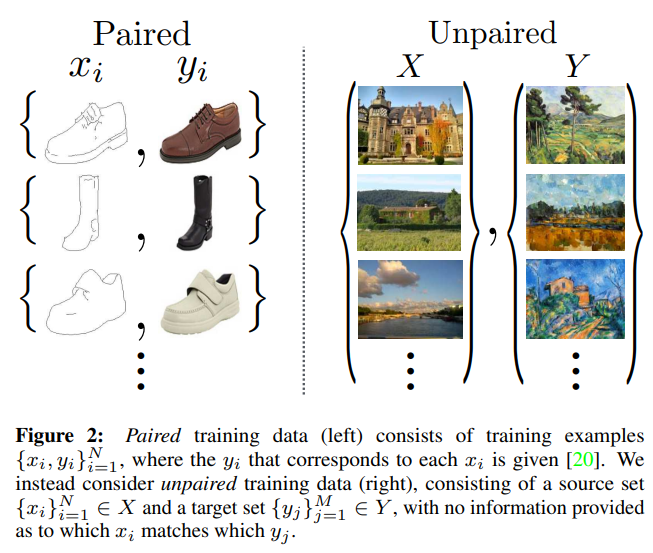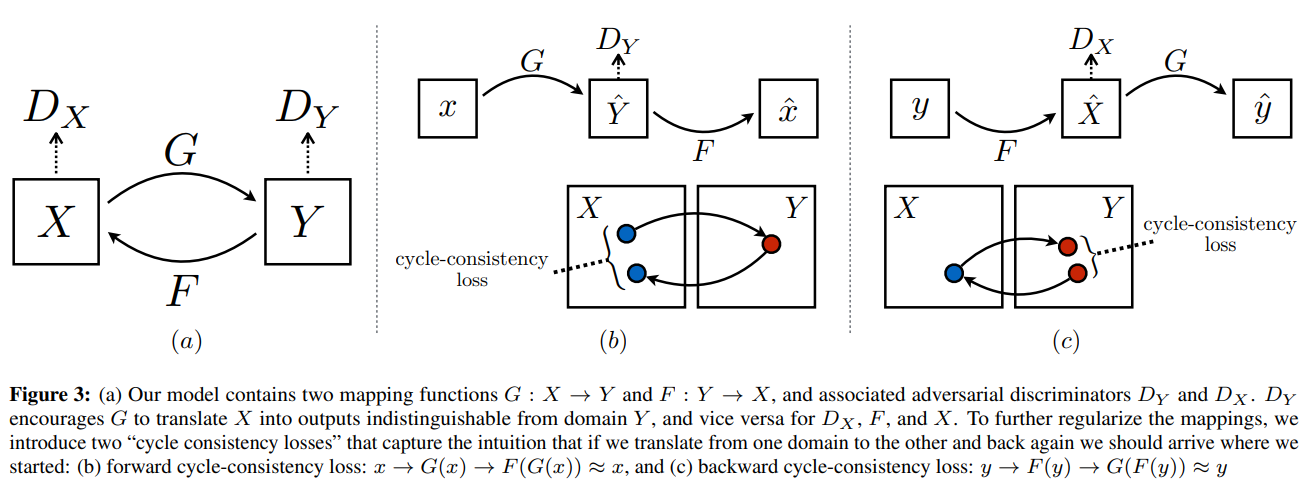| 일 | 월 | 화 | 수 | 목 | 금 | 토 |
|---|---|---|---|---|---|---|
| 1 | 2 | 3 | 4 | 5 | 6 | |
| 7 | 8 | 9 | 10 | 11 | 12 | 13 |
| 14 | 15 | 16 | 17 | 18 | 19 | 20 |
| 21 | 22 | 23 | 24 | 25 | 26 | 27 |
| 28 | 29 | 30 | 31 |
- autoencoder
- 말해보시개 Linux
- ubuntu mount
- docker
- EC2
- unsupervised learning
- pix2pix
- Image to image translation
- linux
- 말해보시개 딥러닝
- bash vs zsh
- git commit
- git log
- gan
- AnoGAN
- aws rds
- bash 명령어
- ubuntu pipe
- F-AnoGAN
- 쏴아리 딥러닝
- anomaly detection
- AWS
- DCGAN
- ubuntu
- ubuntu zsh
- ubuntu grep
- ubuntu 명령어
- AWS EC2
- AWS Certificate
- CycleGAN
- Today
- Total
쏴아리의 딥러닝 스터디
Unpaired Image-To-Image Translation Using Cycle-Consistent Adversarial Networks(2017) 본문
Unpaired Image-To-Image Translation Using Cycle-Consistent Adversarial Networks(2017)
말해보시개 2021. 5. 8. 17:56Unpaired Image-To-Image Translation Using Cycle-Consistent Adversarial Networks(2017)
Abstract
▷ Paired Image-to-image translation 훈련 데이터 획득의 어려움
- Image-to-image translation은 input-target 이미지 pairs를 활용하여, 입력 이미지를 출력 이미지로 맵핑하는 함수를 학습하는 것이 목적입니다.
- 하지만 paired training data를 얻는 활동이 불가능할 수 있습니다.
▷ Paired Input-target 이미지가 없어도 학습 가능한 "Unpaired Image to image tranlslation" 학습방법 제안
- 본 연구에서는 paired examples가 없어도 sourece domain X에서 target domain Y로 이미지를 translate하기 위한 학습방법을 제안합니다.
▷ CycleGAN
- mapping $ G: X\rightarrow Y $를 학습하는것이 목적입니다.
- $ G(X)$로 부터 생성된 Fake 이미지와 Real Y이미지는 구별이 불가능해야 합니다.
- $G$를 학습하는 내용이 under-constrained 상황이기 때문에, Inverse mapping $F: Y \rightarrow X $를 학습합니다.
- cycle consistency loss와 관련됩니다.($F(G(X))\approx X $ (and vice versa))
Introduction

▷ Unpaired Image-to-image translation 훈련데이터 획득의 어려움
- Figure 1의 왼쪽 상단에 있는 것과 같이, Monet의 그림을 Photo로 변경하기 위한 Paired Images(Input-Target) 훈련데이터를 획득하는 것이 가능한가요?
- Figure 1의 왼쪽 하단과 같이, photo를 Monet, Van Gogh, Cezanne, Ukio-e의 그림으로 변경하기 위한 Paired Images 훈련데이터 획득이 가능할까요?
- 위와 같은 Paired 훈련데이터는 현실에 존재하지 않기 때문에, Paired Image to image translation 알고리즘 기반 방법(Figure 2의 좌측 그림)으로는 훈련데이터 획득이 쉽지 않아 Figure 1의 결과를 얻기 어려울 것입니다.
▷ Unpaired Image-to-image Translation Algorithm Motivation
- 본 연구에서는 Figure 1의 결과를 얻기 위한 Unpaired Image-to-image translation 접근 방법을 제시합니다.
- Paired training examples 없이 하나의 image collection으로 부터 다른 image collection으로 translate하기 위한 특징들을 capture 합니다.

▷ Figure 2: Paired & Unpaired trainiang data
- Paired training data(Figure 2 left)
- training example 내 각 $y_i $데이터는 $x_i $와 대응됩니다.
- Unpaited training data(Figure 2 right)
- source set$X $과 target set $Y $이 존재하고, 각 $x_i $ 데이터와 $y_i $데이터의 대응 정보가 없습니다.
Formulation

▷ CycleGAN의 목적은 2개의 도메인 $X $, $Y $간의 mapping function 을 학습하는 것입니다.
- $\left \{ x_i \right \}^{_{i=1}^{N}} \in X $ and $\left \{ y_j \right \}^{_{j=1}^{M}} \in Y $
- Figure 3 (a)에서와 같이 CycleGAN에는 2개의 Mapping이 존재합니다.
- $ G : X \rightarrow Y $
- $ F : Y \rightarrow X $
- adversarial discriminators $D_X $와 $D_Y $가 존재합니다.
- $D_X $: $\left \{ x \right \} $ 이미지와 translated images $\left \{ F(y) \right \} $를 구별하는 역할을 합니다.
- $D_Y $: $\left \{ y \right \} $ 이미지와 translated images $\left \{ G(x) \right \} $를 구별하는 역할을 합니다.
- CycleGAN의 목적함수에는 Adversarial loss와 Cycle consistency loss 2가지가 존재합니다
- adversarial loss: gererated images를 target domain의 data distribution으로 matching
- cycle consistency loss: learned mappings $G $와 $F $가 contradicting each other되는 현상을 방지 합니다.
Adversarial Loss
▷ 2개 mapping function에 Adversarial Loss를 적용.
- $ G : X \rightarrow Y $와 그에 대한 Discriminator $ D_Y$에 대해서, 다음과 같이 목적함수가 표현됩니다.
- $G $는 gererated images $ G(x)$를 domain $Y $와 유사하도록 try합니다.
- $D_Y는 translated samples $G(x)$와 reql samples $y$를 구별하는것이 목적입니다.
- $ F : Y \rightarrow X $와 discriminator $D_X $에 대한 adversatial loss는 유사하게 $L_GAN(F,D_X,Y,X)$로 표현됩니다.

Cycle Consistency Loss
▷ Adversarial Loss의 한계점
- Adversarial training은 이론적으로 mapping $G$와 $F$가 각각 target domain $y$ $X$의 분포를 생성할 수 있습니다.
- 하지만 뉴럴 네트워크는 같은 input images를 활용하여 다양한 target domain의 random permutation images로 연결하기 때문에, 가능한 mapping function들의 경우의 수를 줄여줄 필요가 있습니다.
▷ Cycle-consistent
- 본 연구에서는 이와 같이 가능한 mapping function들의 space를 한정하기 위하여 learned mapping functions은 cycle-consistent해야 한다고 주장합니다.
- Figure 3의 (b)에서와 같이, domain $X$로 부터 각 $x$ image들은 image tranaslation cycle을 통해 다시 original $x$이미지로 되돌아와야 합니다.
- $ x \rightarrow G(x) \rightarrow F(G(x)) \approx x $
- 이를 forward cycle consistency라고 부릅니다.
- 유사하게 Figure 3(c)에 묘사된것 처럼, domain $Y$로부터의 각 $y$ image들에 대하여 $G$와 $F$는 또한 backward cycle consistency를 만족시켜야 합니다.
- $ y \rightarrow F(y) \rightarrow G(F(y)) \approx y $
- cycle consistency를 만족시키기 위하여, 다음과 같이 cycle consistence loss를 설계하였습니다.

Full Objective
▷ Full objective function
- CycleGAN의 full objective는 다음과 같습니다.
- \lambda\는 adversarial loss와 cycle conistency loss의 상대적인 중요도를 control합비다.


Implementation
Network Architecture
▷ Generative networks
- two strided-2 convolutions, several residual blocks, two 1/2-strided convolutions
- instance normalization을 사용하였습니다.
▷ Discriminator Networks
- 70*70 Patch-GANs를 사용하였습니다.
Training details
▷ $L_GAN$
- $L_GAN$(Equation1)에서, negative log likelihood objective를 least square loss로 변경하였습니다.
- training 동안 더 안정적이고 higher quality results를 생성하기 때문입니다.
- 변경된 Equation 1은 다음과 같습니다.

▷ Image Buffer
- model oscillation을 줄이기 위하여 Discriminator $D_X$, $$D_Y$update를 할 때, latest generative networks로 부터 생성된 결과를 사용하지 않고 history of generated imafes를 사용하였습니다.
- 즉, 50개의 previsoud generated images를 저장하는 image buffer를 사용하였습니다.
Results
▷ Paired dataset performance
- Ground Truth input-ourput pair가 존재하는 Paired dataset에 Cycle GAN(unpaired image-to-image translation)을 적용하여, 최근의 연구들와 성능을 비교하였습니다.
- adversarial loss와 cycle consistency loss의 중요성을 연구하기 위하여 several variants에 적용하고 비교하였습니다.
▷ Unpaired dataset performance
- CycleGAN의 generality를 입증하기 위하여 paired data가 존재하지 않는 광범위한 application에 적용하였습니다.
Evaluation
▷ pix2pix에서와 동일한 evalution datasets와 metric을 활용하였습니다 .






Applications





Limitations and Discussion

▷ Failure Case
CycleGAN이 다양한 케이스에서 compelling한 results를 보여주었으나, Figure 12와 같이 여러가지 실패 케이스 들도 있습니다.
같이 보시면 좋아요.
포스팅 내용이 도움이 되었나요? 공감과 댓글은 큰 힘이 됩니다!




